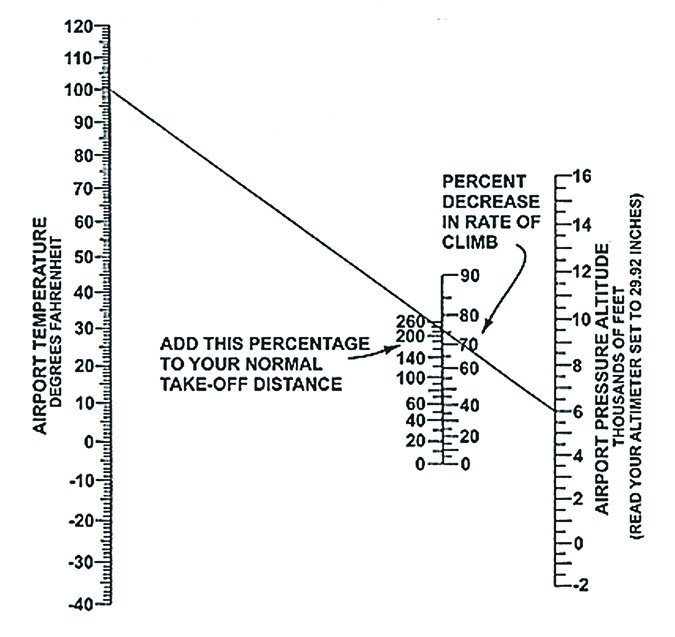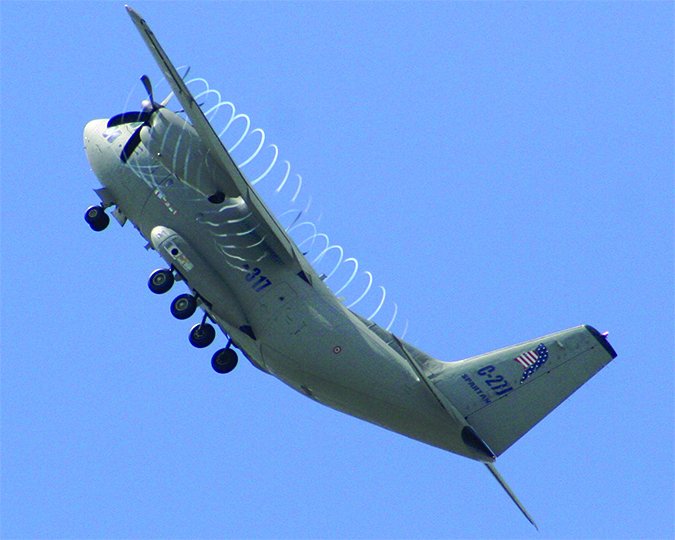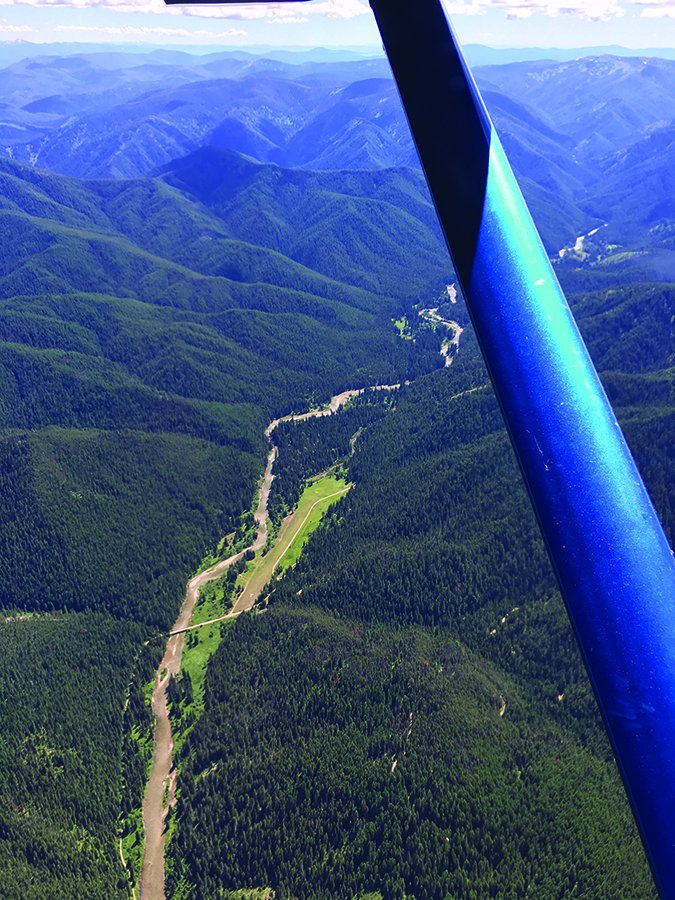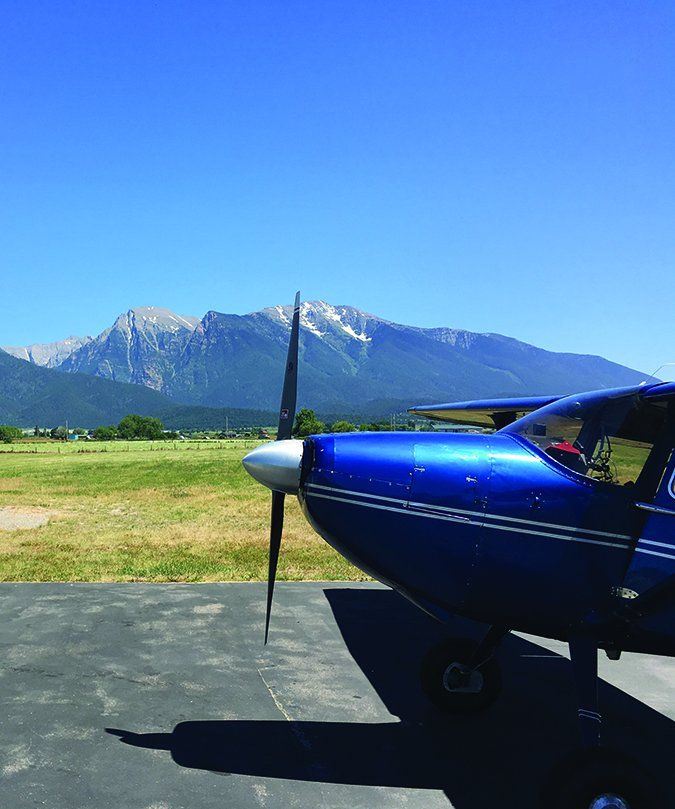When considering landing on a runway with marginal length or a difficult or obstructed departure path, the first stage of aeronautical decision-making is deciding whether to land in the first place. The next one is if you land, can you make it out safely? Quite often there are good reasons to do neither, with perhaps the biggest single factor being density altitude, usually when trying to take off at the planned time.
In case you’re thinking density altitude (DA) is strictly something that concerns mountain-flying enthusiasts like me, you should know it is not a concept unique to the high country. High-altitude pilots just have a head start when it comes to familiarity with DA. Anyone who’s flown in the summertime, including from sea-level airports, has experienced some form of DA.
All About Density
There are three factors to consider in DA—the triple-whammy of temperature, pressure and humidity. “Just as beginner pilots can fixate on an instrument, it is easy for pilots to fixate on a single factor and neglect any others. But thanks to DA posing multiple performance threats, it is the combination of all three that must be considered. We all know it affects the wing’s ability to generate lift, but it also reduces the propeller’s efficiency in generating thrust and the engine’s ability to find enough oxygen to produce power (particularly when humidity is involved). Finally it affects true airspeed so you will have a faster ground speed at landing and a longer ground roll to get up to speed on takeoff.
While DA is a single number, an apparently simple answer to a multivariate problem, our thinking about it should not be one-dimensional. It behooves us to understand what it means since it affects the performance of multiple systems. The most important thing about DA is the density part. Understanding why the wing and engine behave as they do has everything to do with air density and, in the case of engine performance, the proportional amount of oxygen (O2) available. Expressing the effects of reduced air density as an equivalent altitude is just an arcane aviation-centric way of discussing the physics so pilots can relate to it better.
Unfortunately, the calculation of DA is built on a house of cards made up of assumptions about a “standard atmosphere on a standard day,” with lots of empirical formulae to adjust. The approximations and assumptions make these formulae rife with potential errors and approximations that may not reflect real conditions at your locale.
The physical governing the air we fly through air is a law describing an ideal gas. It’s a mathematical way of saying that a given volume of non-compressible gas at a certain temperature and pressure has a specific number of molecules. Changes to temperature or pressure affect that number of molecules, making the air more or less dense.
Density is simply the mass of the gas molecules of the ideal gas in a given volume of air. In a perfect world, we’d employ a complicated series of formulae involving molecular mass, constants, pressure and temperature to determine the air’s density. But since we don’t live in a perfect world, using our aircraft’s performance charts is the next best thing.
The Koch Chart: Density Altitude Convenience
The FAA’s 2008 publication, Density Altitude, guides us through the Koch chart at right, which the agency says is representative of personal airplanes. Basically, place a ruler so it aligns with the current airport temperature and pressure altitude in the left and right columns, and read the percent takeoff distance increase and rate of climb decrease in the center.
The diagonal line shows 230 percent must be added to the standard day/sea level takeoff distance when the temperature is 100 deg. F at 6000 feet pressure altitude. In this example, a takeoff normally requiring 1000 feet of runway now needs 3300 feet. If your sea level rate of climb is 500 fpm, it’s now 120 fpm.
As always, consult the performance charts for your aircraft, which will give you exact values based on DA.

More Than Hot Air
Most pilots associate DA with high temperatures, high altitudes or some combination of the two. Temperature is perhaps the factor we fixate on. But it’s easy to overlook the effect of pressure until you plug the factor into your E-6B and see how dramatically it can swing the results. Here’s a way to see this for yourself. Determine a candidate airport’s field elevation, and park a high pressure system over it. Then change that high to a low pressure system. It would not be at all uncommon to see a one-inch change in an altimeter setting as one result.
For example, if I plug in a temperature of 32 deg. C (90 deg. F) at 4740 feet, my home-field elevation, a single inch of mercury will change my DA from 7000 at a relatively high pressure of 30.50 in. Hg to 8200 feet when the barometer is at 29.50 in. That’s a huge difference, and far greater than the 1000 feet a one-inch change normally would have.
Meanwhile, if I start with the worst-case scenario of low pressure of 29.50 in. Hg, my home airport DA at a temperature of 30 deg. C (86 deg. F) is almost 8000. If I take the temperature up to 40 deg. C (104 deg. F), I am now effectively flying above 9000. Ouch.
Humidity
The amount of water in the atmosphere ranges wildly with temperature and also can impact DA. Fortunately, I live in a place where 30 percent relative humidity is considered muggy, so I rarely have to consider it. That works well for me, because the standard DA calculated by a typical E-6B and the AWOS and ASOS DA reporting systems use equations that don’t factor in humidity. Justifying that relatively casual treatment of humidity, the FAA’s Density Altitude publication (FAA-P-8740-2) seemingly agrees, implying humidity is less of an aerodynamic factor but has more of an effect on engine power. The publication recommends adding 10 percent to the book ground roll in high-humidity conditions due to lower engine performance.
However, just because it isn’t factored into most equations doesn’t mean it isn’t significant. The DA for me on a very hot day would be around 9000 at my home airport where today’s dewpoint is -5 deg. C (which works out to a six percent relative humidity). However, if the dewpoint was 40 deg. C on a 40 deg. C day (100-percent humidity), DA jumps above 10,000 feet! Further, my non-turbocharged engine’s performance would be reduced eight percent. For more on humidity, see the sidebar on the opposite page. Richard Shelquist provides an online resource for calculating the effects of humidity on both DA and engine power at Shelquist Engineering.

Moist Air is Less Dense
When you see condensation forming, you should know all that water came out of the air. While it might seem reasonable to conclude that the air is now lighter from losing that water mass, you would be flat wrong. That’s because when water is dew, it is liquid. When it is in the air, it is a gas. The two states—liquid and gas—are different physical phases of an H2O molecule and follow totally different laws.
When humidity is high, the air you breathe and the air that flows over the wing and into the engine is much less dense. The upshot of that low density is that a molecule of H2O hitting the wing has much less effect than the much heavier N2 and O2 in ambient air. Beyond that, humid air contains less combustible O2 per unit volume, meaning our engines will have less of it to combine with fuel to burn and create power.
Real-World Example
A recent business trip took me over Cayuse Creek (C64), a back-country trip in eastern Idaho. By back-country standards, it isn’t that high (3500 feet) or particularly short (1800 feet). It also affords the opportunity of a go-around, which isn’t all that common in canyon flying.

I was beckoned by its reputation for great fly fishing. My schedule meant arriving in the afternoon when thermals made the canyons bouncy and the air thin. Even with afternoon temps above 85 deg. F, I ran my DA calculation and found the 30.33 altimeter setting was working in my favor. If a departure was not doable that afternoon, I could spend the evening fly fishing, camp the night and depart in the morning with a 20 deg. C temperature swing in my favor, lowering DA by 2000 feet. So I landed.

I waded the stream, chased a deer across the river, tormented a few fish and soaked in the scenery. On my way back to the plane, I hiked the full length of the runway and picked an abort point. If I wasn’t in the air by this point, I would chop power and spend the night.
It took an 800-foot ground roll to get airborne before the abort point, and my climb, while anemic, kept me clear of the trees and canyon walls. I usually count on being in the air within 500 feet when operating out of short fields, but then I also usually try to pick more ideal conditions.
When it comes to departing a more challenging or super-short strip, DA is the single factor that should always have veto power. For example, if Cayuse Creek had less than 1000 feet of runway, an air temperature of 85 deg. F would make it a no-go. Of course, not all aircraft have the short field performance of a Cessna 180. A Lancair, Mooney or a Long-Eze might eat up a lot more runway because the wing is designed for speed over climb. Even though the definition of what constitutes “short” differs for each airframe and engine combination, no matter what engine/airframe combination you have, DA should be a deciding factor.
Performance effects
With respect to performance, DA can be a drag, though it doesn’t add to drag. In fact, less dense air means reduced drag and higher true airspeeds. That means you will actually have faster groundspeed when landing at a high DA. When it comes to landings, that increased groundspeed will increase your landing distance. Since landing distance goes up as the square of the speed, it can have a significant effect on your ability to land short. The corollary is true for ground roll on takeoff, you will need a higher groundspeed before the wing starts flying.
Density altitude also reduces performance in other tangible ways. As oppressive as I find humidity, my O-470 engine likes it even less. The stoichiometry we achieve through leaning our engine is to optimize the balance of combustible O2 mixed with our precious hydrocarbons to produce horsepower. High DA means less O2 per volume of air and even less when the air is humid. High DA should be your cue to lean for maximum performance.
Even when we lean for maximum performance, high DA means reduced power, period. The good news is you may be outside the red zone above 65-percent power where detonation and pre-ignition are factors. The bad news is that the 230 horses you are entitled to with an O-470 like mine are performing more like the 160 horses of a Lycoming O-360. That’s right. The high-performance Cessna 182 you think you are flying is acting more like a Cessna 172. Load it to full gross weight on a hot, humid day and—congratulations!—you’ll have the climb performance of a Cessna 152.
The other overlooked factor regarding DA is its effect on the prop. We all know the wing’s response to less-dense air is to produce less lift and force us to climb with less efficiency. So if we remember the propeller is simply a rotating airfoil, we know the loss of lift translates to a loss of thrust generated per horsepower input.
When you consider all of that together, not only is there less horsepower from the engine, the reduced horsepower available is doing less work because the business end of the prop is also moving less air less efficiently.
Be Ready
Like many things in aviation, DA is more vividly learned by experience. Know how your plane performs when temps are high and performance is sapped. Load your plane full, pick a hot day and go get some real-world experience on a longer runway that gives you some safety margin. Seeing and experiencing your normally peppy aircraft eat runway like a starving iguana and watching the horrible climb rate will help make you a better judge when conditions are closer to the aircraft margin.
When it comes to takeoffs, a higher DA means slower acceleration and a need for greater groundspeed to get the wing flying. It also means really sucky climb performance. If these two factors are compatible with your departure profile, no worries.
But if you have a short runway or obstacles to deal with, take note. Since one of the three factors of DA is temperature, you can consider coming back for the plane when it is cooler. Lower temperatures early in the day are one of the major reasons mountain flying tends to take place in the mornings. The lower DA helps us climb.
The lesson here is to know all of the factors that affect DA and all the ways DA degrades performance. Then factor that understanding into your decisions. If you still have any concerns, remember takeoffs are always optional.
Mike Hart is an Idaho-based flight instructor who’s the proud owner of a 1946 Piper J3 Cub and a Cessna 180. He also is the Idaho liaison to the Recreational Aviation Foundation.





Recently my blood hematocrit was very low, thus blood hemoglobin was less and I experienced low oxygen intake. You could say my physiological density altitude was at 12000 on the ground. I stopped flying for six weeks to rebuild hemoglobin. Eventually my Weakness and rapid pulse went away. I’m glad I had enough sense to not fly.
Kenneth’s comment is right on! High DA affects pilots as well as our aircraft, for the very same reasons… Less O2 per liter of air inhaled.